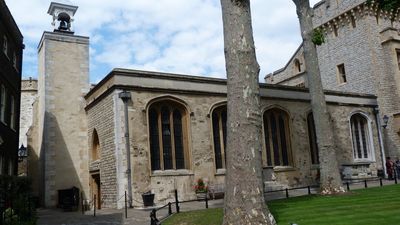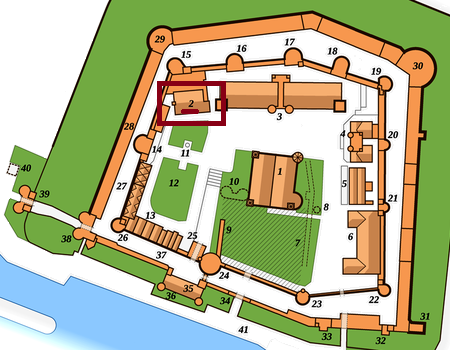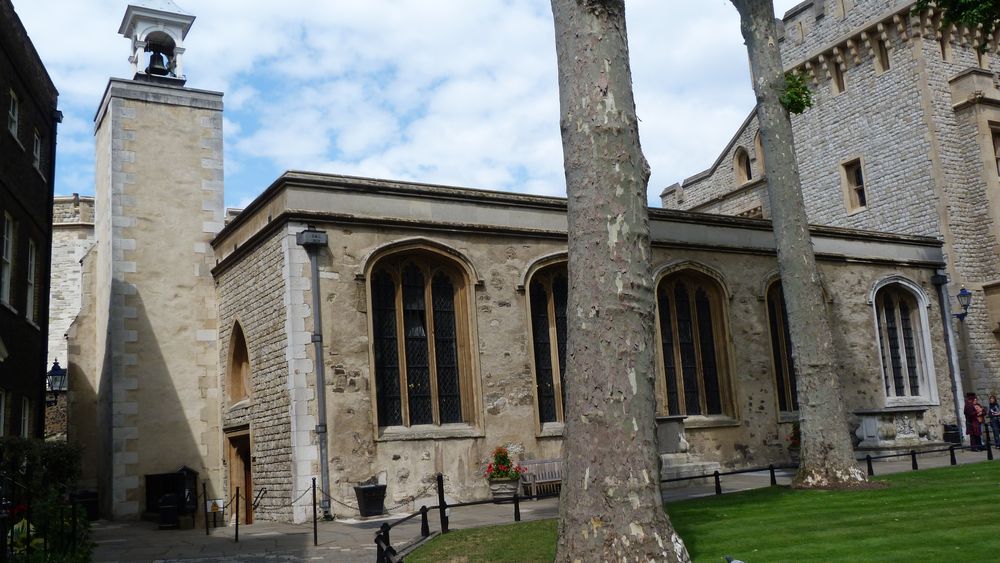The royal chapel of Saint-Pierre-Ad-Vincula is the parish church of the Tower of London. It is a small rectangular stone building located in the northwest corner of the inner courtyard of the tower. It dates from 1520. The chapel now serves as a place of worship for the inhabitants of the Tower.

royal Chapel
The original building dating back to 1100 was destroyed by fire in 1512, the present building was rebuilt for Henry VIII by Sir Richard Cholmondeley in 1519 and 1520, but it is known that a chapel had already occupied these places before the Norman conquest. St Peter ad Vincula is a Royal Peculiar, meaning that it is under the direct jurisdiction of the monarch rather than the bishop of the diocese. It is the burial place of many prisoners executed at the Tower of London.
The chapel contains many superb monuments. In the northwest corner is a memorial to John Holland, Duke of Exeter, a medieval agent of the Tower who died in 1447. In the sanctuary there is an impressive monument to Sir Richard Blount, who died in 1564, and his son, Sir Michael, who died in 1610, the two lieutenants of Tudor de la Tour, who witnessed numerous executions that took place there.
The St. Peter's Chapel is best known as the burial place of some of the most famous prisoners of the Tower, including three queens, namely Anne Boleyn and Catherine Howard, the second and fifth wives of Henry VIII and Lady Jane Gray, who reigned for nine days in 1553. George Boleyn, brother of Anne Boleyn, accused of incest with her, was also buried in the chapel after her execution in 1536, as did Edmund Dudley and Sir Richard Empson, tax collectors for Henry VII. Thomas More and John Fisher, who suffered the anger of Henry VIII and were later executed, and later canonized as martyrs by the Roman Catholic Church, are also buried there, as well as Henry VIII's minister, Thomas Cromwell, the Earl of Essex, who was executed on Henry's orders in 1540.
James Duke of Monmouth, Charles II's illegitimate son, led a rebellion against his uncle James II and was executed on 15 July 1685 on Tower Hill. He is also buried in the chapel. The execution of Monmouth was hidden, the executioner, especially awkward, had to take it five times to detach the head, and still had to finish with a knife.
In 1848 Thomas Babington Macaulay commemorated those who were buried in the chapel in his English history:
In truth, there is no more sad place on earth than this little cemetery. Death is associated with it, not as in the Abbey of Westminster and St. Paul, with genius and virtue, with public veneration and imperishable fame, not, as in our humblest churches and chapels, which is more endearing in social and domestic charities, but with all that is the darkest in man. Nature and human destiny, with the savage triumph of implacable enemies, with the inconstancy, ingratitude, cowardice of friends, with all the miseries of fallen grandeur and flogged fame. They were carried by successive centuries by the hands of the jailers, without the mourning being followed, the bleeding relics of the men who had been the captains of the armies, the leaders of the parties, the oracles of the senates and the tribunals.
The chapel underwent extensive renovation in the Victorian era. During the restoration, the coffins of many mutilated victims of the tyranny of Henry VIII were exposed in the nave. Among these are the skeleton of a woman of "excessively delicate proportions" who is probably that of Anne Boleyn and that of an elderly woman, clearly Margaret, Countess of Salisbury.
A woman of twenty-five and thirty years of age, with a delicate body of body, and of a thin and perfect proportion; the forehead and the lower part, the jaw was particularly well formed. The vertebrae were particularly small. The skeleton also possessed a well-formed round skull, an intellectual forehead, a straight orbital crest, large eyes, an oval face and a fairly square and full chin. The remains of the vertebrae and the bones of the lower limbs indicate a well-formed woman of medium height, with a short, thin neck. The bones of the hand and feet indicate hands and feet delicate and well formed, with tapered fingers and a narrow foot. It looks like the woman was five feet or five feet three inches, no more.
On a soutenu cependant que ce squelette était en fait celui du cousin d'Anne et de la cinquième reine de Henry, Catherine Howard.
It has been argued, however, that this skeleton was in fact that of Anne's cousin and Henry's fifth queen, Catherine Howard.
The skeleton of John Dudley, Duke of Northumberland, Lord Protector of King Edward VI, then a young boy (executed by Mary I for his participation in the usurpation of the crown in favor of his daughter-in-law, Lady Jane Gray and who, with his son Guildford Dudley, was to become the victim of his ambition).
All were removed from the crypt. Queen Victoria had a memorial pavement of green and red marble placed in the sanctuary, which has the names and coats of arms of all those executed by King Henry VIII below. A list of "remarkable people" buried in the chapel between 1534 and 1747 can be seen on a table on the west wall.
Location

See also:
The map of the tower of London with the list of the buildings





















